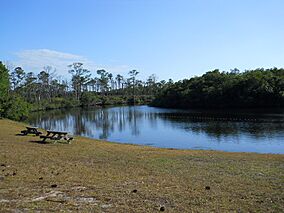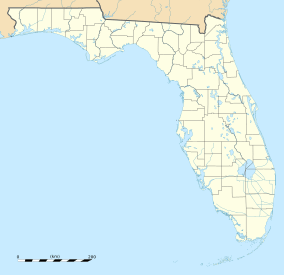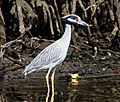Jonathan Dickinson State Park facts for kids
Quick facts for kids Jonathan Dickinson State Park |
|
|---|---|
|
IUCN Category V (Protected Landscape/Seascape)
|
|

Loxahatchee River inside the park
|
|
| Location | Martin County, Florida, United States |
| Nearest city | Hobe Sound / Tequesta, Florida |
| Area | 11,500 acres (47 km2) |
| Established | 1950 |
| Visitors | 172,000 (in 2004) |
| Governing body | Florida Department of Environmental Protection |
Jonathan Dickinson State Park is a fantastic Florida State Park and a historic place. It's located in Martin County, Florida, between the towns of Hobe Sound and Tequesta. This park is special because it has many different kinds of natural areas. You can find sandy sand pine scrub, sunny pine flatwoods, green mangroves, and wet river swamps here.
The beautiful Loxahatchee River flows right through the park. This river is so important that it was named a National Wild and Scenic River in 1985. It was the very first river in Florida to get this special title! The park is also part of the Ocean to Lake Trail. You can find the park at 16450 S.E. Federal Highway, Hobe Sound. It's well known for its exciting Camp Murphy Mountain Bike Trails.
Contents
A Look Back in Time
The Story of Jonathan Dickinson
The park gets its name from a man named Jonathan Dickinson. He was a Quaker merchant, which means he bought and sold goods. In 1696, he and his family were shipwrecked on the Florida coast. This happened close to where the park is today. Jonathan wrote a journal about his adventures. He described meeting local Native American tribes and their long journey up the coast to St. Augustine.
Camp Murphy: A Secret Base
During World War II, the United States Army built a secret base called Camp Murphy in 1942. This base was a special school for training soldiers how to use radar. Radar helps detect objects from a distance. The camp had over 1,000 buildings and housed more than 6,000 soldiers.
Camp Murphy was only open for two years. It closed in 1944. Most of the buildings were taken down, but you can still see some of their foundations. The land was given to the State of Florida in 1947. It officially opened as a state park in 1950.
Trapper Nelson, the Wildman
A man known as Trapper Nelson lived on the banks of the Loxahatchee River. He moved to the area in the 1930s. He lived off the land by trapping animals and selling their furs. People soon started calling him the Wildman of the Loxahatchee. After he passed away in 1968, the state bought his land. It then became part of Jonathan Dickinson State Park.
Fun Things to Do
Jonathan Dickinson State Park offers many fun activities for visitors. You can enjoy bicycling on trails or take boat tours. There's also boating, canoeing, and kayaking on the river. If you like to fish, you can go fishing here.
The park has hiking trails and horse trails for exploring. You can also find picnicking areas and places for swimming. It's a great spot for wildlife viewing, where you might see many animals. The park also has full camping facilities if you want to stay overnight.
The Elsa Kimbell Environmental Education and Research Center is inside the park. It has cool exhibits about the park's nature and history. You can also take a 44-passenger boat tour to visit Trapper Nelson's homestead.
The Park on Screen
Jonathan Dickinson State Park was used to film part of a BBC show called Walking with Monsters. This part of the show was about ancient animals living in Late Carboniferous Kansas.
Popular mountain bike channels on YouTube, like BKXC and BCPOV, have also shown the park's Camp Murphy Mountain Bike trails.
Gallery
-
Two white-tailed bucks on the Loxahatchee River
-
Yellow-crowned night heron on Kitching Creek
-
Ibis on the Loxahatchee
-
Pileated woodpecker on Kitching Creek
-
Great Blue Heron on the Loxahatchee
-
A raccoon
-
An alligator on the Loxahatchee
See also
- Hobe Mountain















